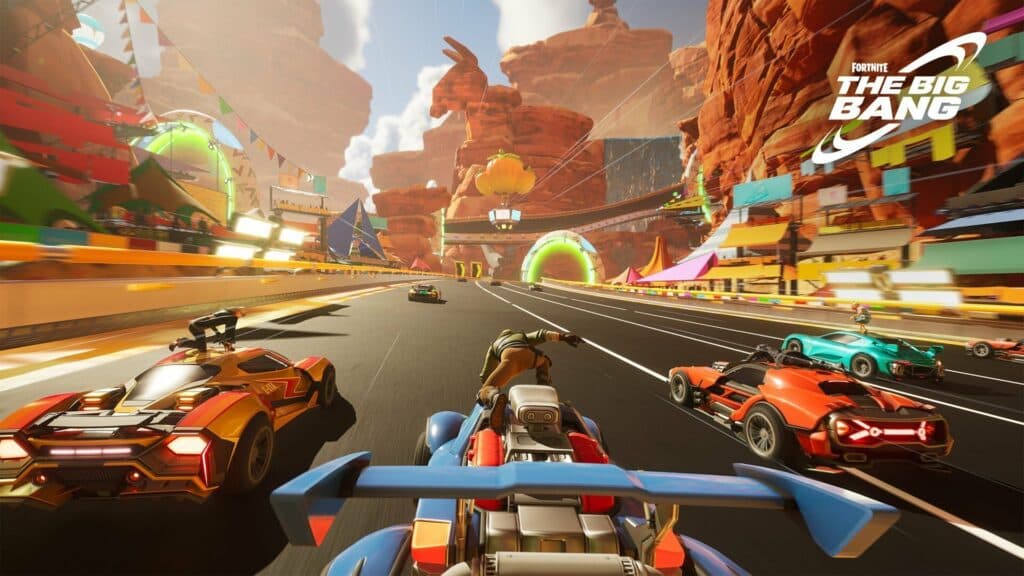Use these tips to get out there and make your opponents eat your dust.
Rocket Racing, the arcade racing game mode in Fortnite from Rocket League creators Psyonix, is hiding mechanics under the hood. Here's how they work.
Rocket Racing can seem like a simple, streamlined arcade racer without much mechanical expression going on. The tutorial introduces you to the basics, but fails to cover several important techniques that can make all the difference in a game where tenths of a second matter. Here are the most important hidden Rocket Racing mechanics that the game doesn't explain to players.

How Rocket Drift actually works
While Rocket Racing does offer the option to automatically trigger a regular drift when steering sharply, you're going to be manually Rocket Drifting around every corner in the game instead. The Rocket Drift is the most important mechanic in Rocket Racing. It's how you both maintain speed, increase gain, and acquire boosts. When you Rocket Drift, three things are happening. Firstly, your car begins the Rocket Drift by maintaining most of the speed you had going into the drift. So, the faster your car was moving before the drift, the faster it moves during the drift. Secondly, you start building up Boost Meter, which is used for Rocket Boosts. The longer you drift, the more progress you'll get towards your next boost. Finally, you start building up a temporary speed boost that increases in magnitude the longer you've been drifting.
As you hold a drift, you will eventually begin to lose speed. Over time, the car resets towards its natural speed of between 560 to 580 kilometers per hour. Unless the turn is long enough that you need to keep holding it, it's better to reset the drift by inputting a very brief Rocket Drift in the opposite direction. You can also input a longer drift input in the opposite direction to begin a Chain Drift. Chain Drifts let you build up speed and Rocket Boosts on straight sections. This lets you build boost for later where drifting in one direction alone would send you slamming into the wall.
If you've seen cars fishtailing along straight sections of the map, this is what they're doing. Look to briefly exit drifts as your speed resets before entering another. This lets you maintain more speed as you enter the second drift, therefore making you faster as you exit the drift.
Air Drifting
This mechanic is mandatory for several tracks, particularly K2 Raceway Deux, but the game doesn't take any time to explain it. If you hold down the Rocket Drift button while you jump into the air and float, your car will remain in the same orientation that it left the ground in. This means you can enter a drift, then jump and keep your car oriented the way you want while you float, before being able to continue that very same drift when you next hit the ground.
In order to do this, enter a Rocket Drift and then jump. As long as you keep the throttle engaged, the car will float along. During this, it can be directed by the usual steering controls, in the orientation that it left the ground. This lets you skip corners, maintain a drift while passing over an obstacle, and otherwise maintain speed and Rocket Boost progress while going airborne. Not using this technique will waste all of your Rocket Drift speed that you've built up. It will also send the car facing in the direction you're traveling, which you won't always want.
Aerial Tilt
Aerial Tilt is a way to direct your car while in the air to either gain or lose air time. Tilts are exceptionally simple, but you might not have noticed them if you weren't aware of their existence. While in the air, input either the forward or backward directional inputs.
Inputting forwards will tilt the car's nose down, losing altitude and sending you into a slow dive. This is most often used to try and hit boost pads on walls after getting lots of air time. Inputting backward will tilt the car's nose up. This creates more wind resistance under the car and allows you to stay in the air for longer. While Aerial Tilting the nose up, you can tap the float button to maintain height and momentum without needing to constantly use your limited fuel for floating.
Air Dodge Boosting
Air Dodge Boosting is the most complicated mechanic of them all. So much so that it's not entirely clear whether it was intentionally put into the game by Psyonix or not. When you Air Dodge, attaching your car to a floor, wall, or roof, it grants you a small and hidden speed boost. The speedometer won't change, but there is a significant boost in speed just from air dodging. On its own, this is mostly used to Air Dodge upwards while in the air to cross a long gap.
However, if your car leaves a ledge while you are Rocket Drifting in one direction and then you Air Dodge in the other direction, if timed perfectly, it will give you an absolutely massive speed boost. This application is far more niche, but is used in multiple World Records to gain precious seconds.
These are the most important hidden Rocket Racing mechanics for taking first place. With just a few days until the ranked season ends, use these tips to get out there and make your opponents eat your dust.